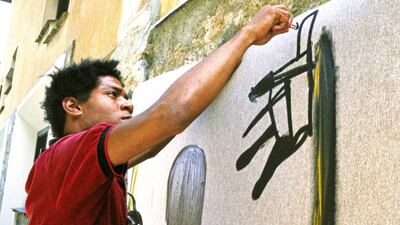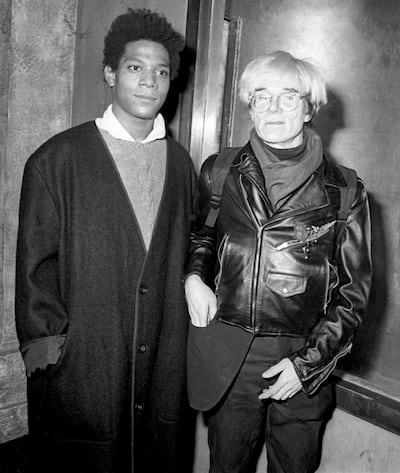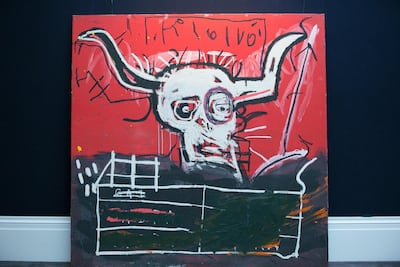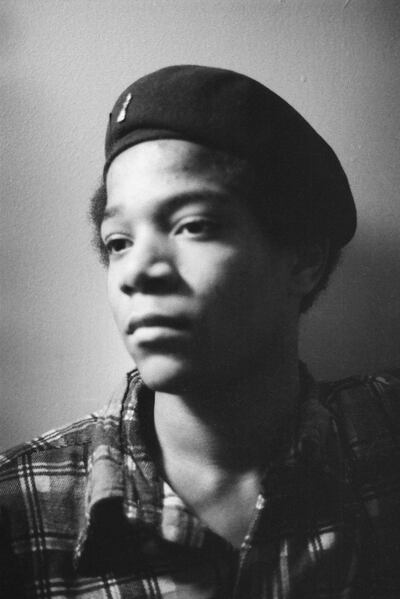"In the 1980s, if you wanted to see the real art," said curator Jeffrey Deitch at Louvre Abu Dhabi last night. "It wasn't in the galleries. It was on the streets and on the subway cars."
Deitch was reunited on Wednesday with Leonard McGurr, the graffiti artist better known as Futura, for a discussion about Jean-Michel Basquiat, the breakaway star from the wild style graffiti years of New York in the late 1970s and early 80s.
The city was then recovering from bankruptcy, violence was at a high, and the downtown scene had turned into a crucible of creativity and imagination.
“You can compare it to what was happening in Paris at the turn of the century,” Deitch continued, adding: “You had a mix of art forms coming together. You had wild style graffiti, Steve Reich, new wave, no wave, hip hop, breakdancing.” He paused. “But rougher.”
From homeless to world famous
Basquiat took the cut-up and sampling aesthetics of hip-hop and brought it into his paintings, mixing the language of graffiti from the street with powerful, primitive forms and a direct, childlike symbolism. He wasn’t appropriating street style, though: Basquiat began as a graffiti artist, writing concrete poetry on the downtown streets under the alter ego “Samo”.
“We didn’t know who he was but we knew Samo,” explained Futura, an artist who also made the leap from tagging subway cars to selling paintings in galleries.
“He went from homeless on a park bench in Tomkins Square Park — and I don’t know if you know New York, but that’s real New York — to being one of the greatest artists of the twentieth century.”
Basquiat became a fixture on the downtown scene: he dated Madonna, who was then just a New York newcomer, hung out with Andy Warhol at the Factory, and appeared in the video for Blondie's single Rapture. These nightlife appearances aren't just celebrity fodder: the social spaces of New York, from the Mudd Club in lower Manhattan to Fashion Moda in the South Bronx, were key to the creativity of the era, where dance, art, and music forms mixed.
“The connections were very social,” Deitch says. "I remember once I got to meet Maja Hoffman, a very important patron, who was very young then — I took her up to the South Bronx to see Fashion Moda. A lot of this history is just personal.” Deitch wrote the major review of the Times Square Show in 1980, where many of these formerly underground artists were introduced to a wider public, and he also brought them to a show in Hong Kong.
Though now Deitch has worked with blue-chip names and went to Harvard for an MBA, it is notable that when he made the leap from New York gallerist to head of the Los Angeles Museum of Contemporary Art, in 2010, his first major show was the blockbuster "Art in the Streets", of graffiti art.
“I’ve been trying to get this work into museums for 30 years,” he notes. “It just took a while.”
It seems strange now that anyone would have fought to get Basquiat's Cabra into the museum: the painting punches at such a high level it seems destined for hallowed halls.
Dominated by the image of a red bull, it shows the importance of the symbol of the bull to Basquiat: as an identification with Picasso, for whom the icon was also crucial; throughto famous boxer of Muhammed Ali, who, like Basquiat, wanted to be the greatest.
“He looked so sweet and innocent, but he was as an ambitious as artist as I’ve ever met,” commented Deitch. “He was very conscious of his position as a young black man who had to fight his way to get to the top.”
'It wasn't about money for him'
LaBouvier, who moderated the talk as a guest curator, underlined the significance of Basquiat being the first black artist to make it to the upper echelons of the art world without being pigeonholed as a black artist.
“That has endeared him to us,” she said, talking about the last appeal of his work. “So much of global pop culture is black American culture, and that has allowed people to connect with him.”
Futura, who collaborated with him and other now famous graffiti names, such as Keith Haring, was just a friend. He told the audience a story of buying some of Basquiat's postcards for $500 after he happened to have money after a gig in London. (If $500 for a few postcards seems high, keep in mind that in 2017 Basquiat broke the record for the highest price for an American artist at auction, with Untitled (1982) at Sotheby's, which went for $110,487,500.)
A few years later, when Basquiat had begun selling his work, “he reimbursed me,” recounted Futura. “I said no, but he knew I needed the money. And I did! It wasn’t about the money for him. That wasn’t his reward. He just wanted to make the work.”





